Design and Development of A Drone Enabled Spraying System for Enhancing Agricultural Productivity- Airavat-X
Sanket Thorwat
Department of Aerospace Engineering
Sandip University
Nashik, India
Prof. Amar Kulkarni
Assistant Professor
Department of Aerospace Engineering
Sandip University
Nashik, India
Abstract The Airavat-X agriculture drone is primarily designed for crop spraying applications. Equipped with a tank that can hold liquid pesticides or fertilizers, the drone can efficiently spray on the crops from the air, offering several advantages over traditional ground spraying methods. Moreover, the drone can apply the chemicals more accurately than traditional ground spraying methods. With its advanced sensors and software, the Airavat-X can help ensure that the chemicals are applied at the correct rate and in the right areas. This can reduce waste and minimize the risk of over-spraying or under-spraying. Overall, the Airavat-X is a versatile and powerful tool that can revolutionize the way farmers manage their farms. With its advanced capabilities and features, the drone offers a more efficient, precise and environment friendly alternative to traditionalfarming methods.
Keywords Agriculture, drone, motor, tank, payload
I. INTRODUCTION
In the modern agriculture, precision and efficiency are paramount to ensuring sustainable and productive crop cultivation. Traditional methods of fertilizer application, such as manual spraying and ground-based equipment, often fall short in achieving the desired level of precision and uniformity. This is where Airavat-X, an agricultural drone specifically designed for fertilizer spraying, emerges as a transformative solution. Traditional fertilizer application methods often result in overapplication, increasing production costs and reducing profit margins for farmers. Precision agriculture practices, such as those enabled by Airavat-X, can optimize fertilizer usage, saving farmers money while improving crop yield. Airavat-X is a culmination of cuttingedge technology and innovative engineering, meticulously crafted to address the challenges faced by farmers in fertilizer application. Its unique design and advanced capabilities make it an indispensable tool for precision agriculture, empowering farmers to optimize crop health and yield while minimizing environmental impact.
Pooja Mohanty
Department of Aerospace Engineering
Sandip University
Nashik, India
Dr. Nirmal Halder
Assistant Professor
Department of Aerospace Engineering
Sandip University
Nashik, India
A. Literature review
Zhang Dongyan et al. (2015) [1], a backpack sprayer can be fitted with a harness so that the user can wear the sprayer on their back. About 20 liters is the maximum volume of liquid that could fit in the tank. A grasp lever is used to keep pressure constant, making the output of the smoother than the handheld sprayer mechanism's output is the backpack sprayer.
A basic, low-cost backpack sprayer that produces little pressure and primarily lacks features such as gauges, assure regulation and a high-pressure pump.
Huang et al. (2015) [2], sprayers that run on engines produce more consistent results and cover the spray swath more evenly. Other hand-operated sprayers exist, but they are not widely used in agriculture. Additionally, compared to manual spraying, motorized sprayers offer noticeably more uniform coverage and operate at a constant speed. They can also spray at a higher pressure for improved coverage.
Yallappa D et al. (2017) [3] has published a paper entitled “Quadcopter UAV based Fertilizer and Pesticide Spraying System”, in which they give a brief idea about the UAV pesticides sprayer.
S. R. Kurkute et al. (2018) [4] in his paper, discussed the use of quadcopters for reconnaissance, as well as demonstrating that small scale UAVs have a broad range of applications, such as safety inspection of construction tools, traffic monitoring, search and rescue operations and temperature and altitude measurements.
Rahul Desale et al. (2019) [5] in his paper, concluded that during the Tillering and Flowering stages of rice plants, the same spraying volume was used to compare the effects of different nozzle 14 treatments on droplet deposition and rice planthopper control. There is a significant difference between the droplet density between the nozzles, as shown by the results.
Prof. B. Balaji (2018) [6], the structural, system, propulsion, aerodynamic and integration related problems pertaining to
solar-powered aircraft were covered. Furthermore, batteries, power management systems, photovoltaic systems, and structural materials make up the technological status of solar aircraft.
Prof. P. Mone (2017) [7], discusses a number of energy extraction and storage techniques, compares their effectiveness to desired features on solar-powered models and provides some guidance on how to choose the best techniques.
II. METHODOLOGY
A. Components
1. Hobbywing X8 Brushless DC Motor
Hobbywing X8 motors are typically brushless, offering higher efficiency, longer lifespan, and better performance compared to brushed motors. Motors like the X8 are often designed to deliver high power and efficiency, making them suitable for various applications, including multirotor drones.

2. Propellers
The 3090-propeller made of special high-strength carbon fiber is solid and light, andguaranteesgreatconsistencyandexcellent dynamic balance. This makes it ideal for carrying heavy payloads of fertilizer or other agricultural chemicals.

3. Lithium-Ion battery
Mpower 16800 Li-Ion Battery is a versatile and reliable power source designed for agriculture drones with its high capacity. This battery provides a convenient and safe, with 16800 mAh capacity, extends flight time for enhanced productivity in agricultural applications.With a 6S4P configuration and 11 C discharge rate, this battery offers stable and consistent power output for demanding tasks. Airavat-X use two sets of Mpower 16800 batteries in series connection.

4. Flight controller
Eklavya V-1 integrates the advantages of the classic flight controller K3A, and strengthens compatibility and multiple redundancy schemes to form a redundant control system with superior performance, strong reliability and effective guarantee work safety. Eklavya V-1 comes with intelligent vibration analysis function, which can judge the vibration of the aircraft in real time. Eklavya V-1 is equipped with triple redundant IMU and dual redundant barometer sensors.
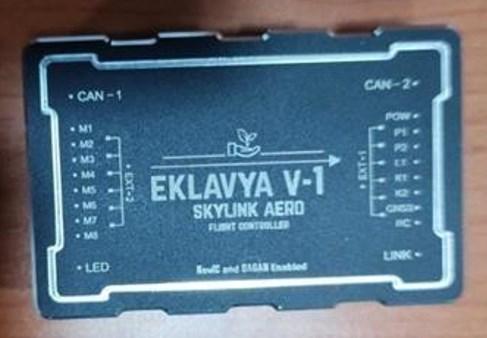
5. SIYI MK15 Remote Controller
The SIYI MK15 is a powerful and user-friendly remote controller that is designed for agricultural and industrial drones. It features a 5.5-inch touchscreen display with 1080p resolution, for clear and easy viewing. The remote controller also has a long-range 5.8 GHz communication system that provides up to 15 km of range, making it ideal for controlling drones over long distances.
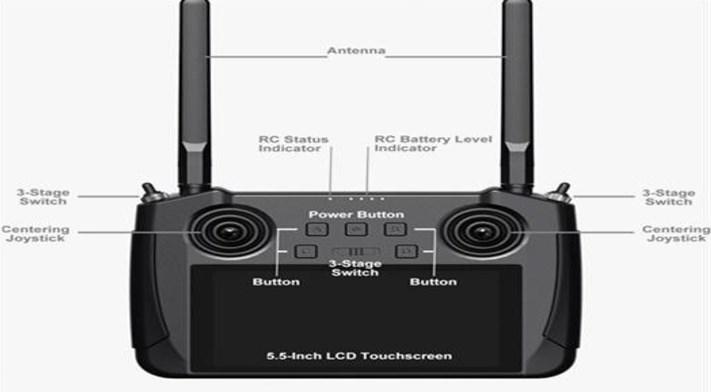
6. Tank
This 10 L tank used in Airavat-X is made from plastic and is designed specifically for use with agriculture pesticide/ herbicides/ fungicides/ nutrients spraying purposes.
Fig. 1. Motor Fig. 2. Propellers Fig. 3. Battery Fig. 4. Flight controller Fig. 5. Remote controller
7. Pump motor
Pump motor is attached below the tank which is used to pump the pesticides out from the tank.
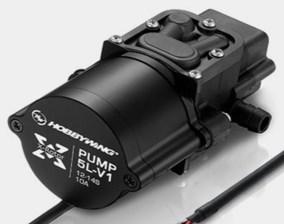
8. Nozzles
Two Y-type nozzles areused in theAiravat - X. These nozzles are attached below the motors with the force of the air added to reach the chemicals to the plant without drift. The nozzle tips used in these rods are flat fan models. Both I-type and Ytype of nozzles can be used.

9. Flow sensor
The flow sensor used in the drone is to fulfill the purpose of indicating the level of water in thetank. Purpose of using this sensor is, during the mission plan it will help us to pause the mission once the water in the tank gets empty. Where it indicates to the pilot to get the tank refilled and continue the spraying.
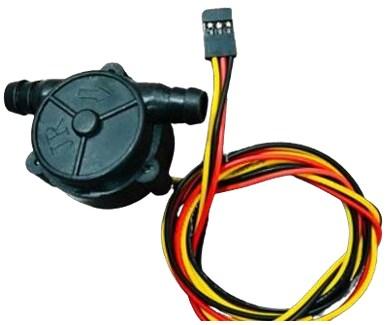
10. Global Positioning System
The GPS module provides precise location information, featuring dual-frequency capabilities (GPS and Beidou) for enhanced accuracy. With a variety of sensitivity modes, the module ensures reliable positioning even under challenging conditions. The compact size and low power consumption make it an ideal choice for drone applications.

11. Power Distribution Board
A Power Distribution Board (PDB) serves as a central hub within an electrical system to manage the distribution of electrical power from a main power source to various subsidiary circuits and devices. Its primary purpose is to ensure safe, efficient, and organized power distribution within a building, facility or equipment.
 Fig. 6. Tank
Fig. 7. Pump motor
Fig. 8. Nozzles
Fig. 9. Flow sensor
Fig. 10. Global Positioning System
Fig. 6. Tank
Fig. 7. Pump motor
Fig. 8. Nozzles
Fig. 9. Flow sensor
Fig. 10. Global Positioning System
12. Trans-receiver and antennas
Radio transceivers are devices that combine a transmitter and a receiver into a singleunit, thus permitting bidirectional communications. They may be used by UAVs and unmanned vehicles to communicate with each other or with a ground control station (GCS). Control signals, telemetry and payload data such as sensor readings and streaming video may all be transmitted or received by drone radio transreceiver.

13. Electronic Speed Controller
The job of the ESC is to switch on power to the motor coils at incredibly fast rates. It works by switching the frequencies of the transistors in the ESC, to throttle the motors. Mostly having three phase power supply, a microcontroller interrupts the input signal, and the built-in program appropriately controls the motor. The correct phase of the current fed to the motor varies with the motor rotation, which must be considered by the ESC.
B. Working
The brains of the operation is the flight controller. It receives information from the GPS about the drone's location and uses that data to control the motors via the Electronic Speed Controllers (ESCs). The ESCs adjust the speed of each motor for stable flight. The pilot uses the remote controller to send commands to the transmitter, which then relays those signals to the receiver on the drone. The receiver communicates with the flight controller, allowing the pilot to guide the drone's movement. The battery provides power to the entire system, including the PMU (Power Management Unit), which ensures proper voltage distribution. The payload tank holds the pesticide mixture and a pump pushes the liquid through the nozzles, creating a fine spray that gets applied to the crops as the drone flies along its pre-programmed route.
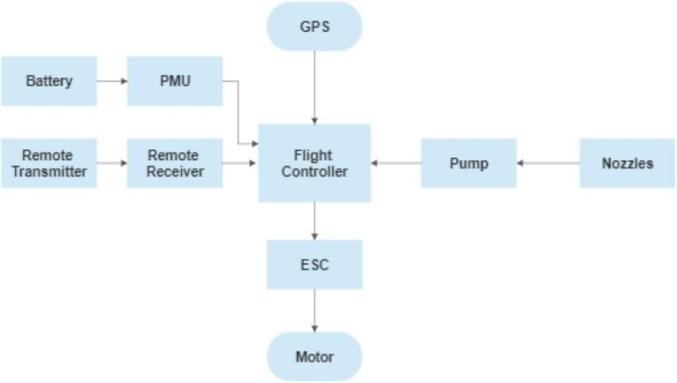

C. Design
The CAD model serves as a virtual representation of the physical drone and can be utilized for various purposes. Solidworks 2022 is used for the designing of this drone.
 Fig. 12. Trans-receiver and antennas
Fig. 13. Block diagram of working process
Fig. 14. Connections of the drone
Fig. 12. Trans-receiver and antennas
Fig. 13. Block diagram of working process
Fig. 14. Connections of the drone
2278-0181 http://www.ijert.org
Vol. 13 Issue 5, May 2024
D. Description of the drone
E. Grid generation
The total mass used in the FEA is derived by regarding the maximum possible mass of the equipment. A 2nd order Quadrilateral and Triangular mesh was applied to Shell Model and Hexahedral and tetrahedral was applied to the Solid model. These types of mesh supports plasticity, hyper elasticity, creep, stress stiffening, large deflection and large strain capabilities.

Loading/ Boundary conditions Value
But for safety reasons we have considered a force of 95N.
Table 3 Loading and boundary conditions for safety factor, total deformation and equivalent stress
Maximum take-off weight 24.4 kg
Dimensions (l*b*h) in mm 2069 * 1614 * 667
Propeller dimensions Diameter: 30 in
Maximum endurance 16 min
Maximum range 0.2 km
Maximum speed 10 m/s
Maximum altitude 30 m Battery capacity 16800 mAh
B. Results

Fixed
Fixed Support Propeller Hub
RPM 4072
III. RESULTS AND CALCULATIONS
A. Loading and boundary conditions
Loading/ Boundary conditions Value
Fixed Support Landinggear
Load 95 Nacting on the arm rods.
Table 2 Loading and boundary conditions for life of propeller
Below are the loading and boundary conditions that we have given to our model. These boundary and loading conditions are based on real life conditions in which the drone will be tested. It can be calculated as follows:
Force acting per arm = (Total MTOW in N / No. of arms) *
Factor of Safety = ((24.4 * 10) / 4) * 1.5 = 91.5 N

 Fig. 16. Mesh of the drone Table 1. Description of the drone
Fig. 17 Life of propeller
Fig. 18. Safety factor
Fig. 19. Total deformation
Fig. 16. Mesh of the drone Table 1. Description of the drone
Fig. 17 Life of propeller
Fig. 18. Safety factor
Fig. 19. Total deformation
REFERENCES
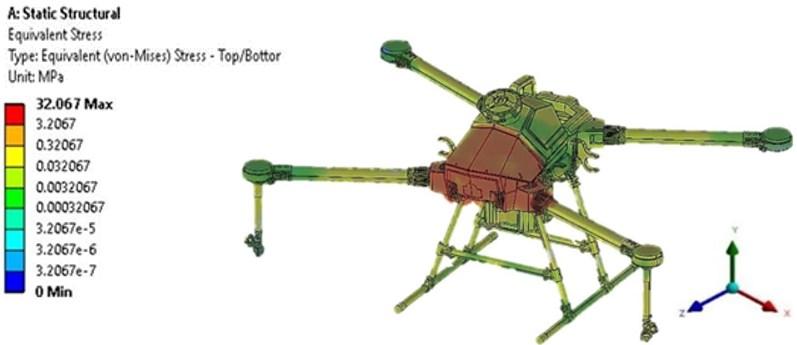
Fig. 20. Equivalent stress
C. Calculations
The overall weight of the drone is calculated by adding the total weight of components and the weight of payload.
Overallweight= Payload +Weight of components
= 10 kg + 14.4 kg = 24.4 kg
Thrust produced by one propeller with one motor = 9.2536 kg
Total thrust produced = 4 x 9.2536 = 37.0144 kg
Thrust to weight Ratio = Thrust produced / total weight of drone
= 37.01 / 24.4
= 1.51 : 1
D. Discussions
The drone design has a minimum 2 factor of safety and it is totally safe. As the airframe structure is manufactured using strong materials like aluminum and carbon fiber, the airframe can easily withstand the load forces exerted. As per Static Analysis, maximum deformation is 0.0071 mm and maximum stress is 32 MPa, which is under the limit of maximum loading capacity of the material.
IV. CONCLUSION
This agricultural drone project has the potential to revolutionize precision agriculturepractices by introducing a more efficient, precise and environment friendly method of fertilizer application. The drone's autonomous capabilities, will enable farmers to minimize waste, and enhance crop health and productivity. This technology has the potential to significantly improve agricultural yields and reduce environmental impact, contributing to a more sustainable and productive future for farming.
[1] Zhang Dongyan, Chen Liping, Zhang Ruirui, Xu gang, Lan Yubin, Wesley Clint Hoffmann, Wang Xiu, Xu Min, “Evaluating effective swath width and droplet distributionof aerial spraying systems on M18B and Thrush 510G airplanes”,April 2015, Int J.Agric.& Bio Eng, Vol 8 No.21.
[2] Huang, Y. Hoffmann, W.C. Lan, Y. Wu and Fritz, B.K, “Development of a spray system for an unmanned aerial vehicle platform”, Dec 2015, Applied Engineering inAgriculture,25(6):803-809.
[3] Yallappa D., M. Veerangouda, Devanand Maski, Vijayakumar Palledand M.Bheemanna,“Development and Evaluation of Drone mounted sprayer for Pesticides Applications to crops.” Oct. 2017, Research Gate, Conference paper.
[4] S. R. Kurkute, B. D. Deore, Payal Kasar, Megha Bhamare, Mayuri Sahane, “Drones for Smart Agriculture: ATechnical Report”, April 2018, IJRET, ISSN: 2321-9653.
[5] Rahul Desale, Ashwin Chougule, Mahesh Choudhari, Vikrant Borhade, S. N. Teli, “Unmanned Aerial Vehicle for Pesticides Spraying” April 2019, IJSART, ISSN: 2395- 1052.
[6] Prof. B. Balaji, Sai Kowshik Chennupati, Siva Radha Krishna Chilakalapudi, Rakesh Katuri, kowshik Mareedu, “Design of UAV (Drone) for Crops, Weather Monitoring and For Spraying Fertilizers and Pesticides.”, Dec 2018, IJRTI, ISSN: 2456-3315.
[7] Prof. P. Mone, Chavhan Priyanka Shivaji, Jagtap Komal, Nimbalkar Aishwarya Satish, “Agriculture Drone for Spraying Fertilizers and Pesticides”, Sept 2017, International Journal of Research Trends and Innovation, ISSN 2456-3315, Volume 2, Issue 6.
[8] F. G. Costa, J. Ueyama, T. Braun, G. Pessin, F. S. Osorio, P. A. Vargas, “The Use of Unmanned Aerial Vehicles and Wireless Sensor Networking Agriculture Applications”, 2012, IEEE International Geoscience and Remote Sensing Symposium 2012.
[9] Spoorthi S., Shadaksharappa, B., Suraj S., Manasa V. K., "Freyr drone: Pesticide/ fertilizersspraying drone-an agricultural approach.",2017, IEEE 2nd International Conference on In Computing and Communications Technologies, pp. 252-255.
[10] G. Ristorto, F. Mazzetto, G. Guglieri and F. Quagliotti, “Monitoring performances and cost estimation of multirotor unmanned aerial systems in precision farming.”, 2015, International Conference on Unmanned Aircraft Systems (ICUAS), pp. 502–509.
